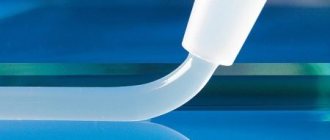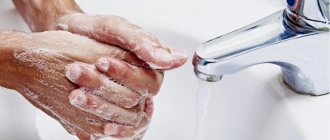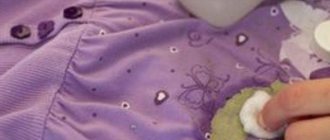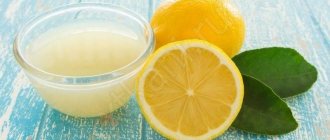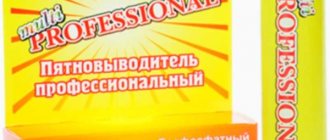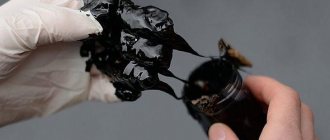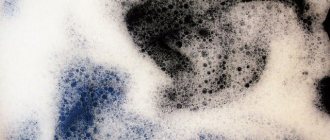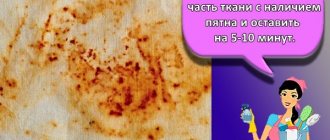Vaseline is a natural ointment-like product that is widely used not only in cosmetics, but also in everyday life. It is made from mineral oil and paraffin. It mixes well with various oils, which is why it has found its strong niche in cosmetology. A variety of skin care products are produced based on it. But Vaseline is insoluble in water and even alcohol. When it gets on fabric and other surfaces, it leaves behind a noticeable greasy stain that cannot be easily washed off. Therefore, many people have a question about how to wash off Vaseline. From our article you will learn how to remove Vaseline stains yourself, without resorting to professional cleaning services.
Features and application of technical Vaseline
06/26/2019 Vaseline has been known since the 19th century; since then it has become widespread in various areas of our lives. It looks like a yellow or gray-brown ointment. Vaseline is produced by mixing solid and liquid hydrocarbons. The basis is any oil (except castor); it is added to solid paraffins. Next, the material is cleaned using sulfuric acid or bleaching clay. Pure Vaseline is colorless and odorless and has a creamy sheen.
Petrolatum
Details Category:
PETROLATUM
(Adeps mineralis, mineral fat) is prepared from petroleum (in the USA it is often called “petrolatum”); an ointment-like mass that has neither taste nor smell (sometimes a faint smell of kerosene), color from yellowish through red even to black - with incomplete cleaning and white - with complete cleaning. Vaseline melts at a temperature of 30-47°, depending on the purpose of use; upon melting, a transparent oily liquid is formed, which upon further heating begins to boil (190-200°) and distills within 250-300°, decomposing into more volatile products. The specific gravity varies depending on the production method or origin of the starting material and ranges between 0.83 and 0.88. Vaseline is chemically neutral, does not produce soap with alkalis, and does not go bitter, which is its great advantage compared to vegetable and animal fats; Vaseline is insoluble in water and glycerin, slightly soluble in anhydrous alcohol, more soluble in ether and completely soluble (when heated to the melting point) in benzene, chloroform, carbon disulfide, petroleum, essential and fatty oils; when fused with fats and waxes, it also dissolves completely in all proportions. Caustic alkalis have no effect on petroleum jelly either at ordinary or at high temperatures; In this way, Vaseline differs from organic fats, due to which the slightest admixture of them in Vaseline can be detected. Bromine and iodine dissolve in petroleum jelly already at ordinary temperatures, sulfur - when heated to 120-130°. Vaseline is a mixture of liquid and solid high molecular weight hydrocarbons; for example, American petroleum jelly contains fatty hydrocarbons with a composition from C12H26 to C20H42.
Methods for obtaining petroleum jelly from petroleum. To obtain petroleum jelly from light Pennsylvanian (waxy) oil, it is distilled until the remainder of the oil reaches the desired specific gravity of 0.865-0.875; After this, it is filtered while hot for purification through bleaching earths (Fuller's earth, floridin, etc.), which adsorb resinous and coloring substances. The color of the resulting Vaseline depends on the % of soil applied. To obtain petroleum jelly from heavy paraffinic oils (Galician, Grozny), the latter are subjected to distillation with superheated water steam until gasoline and kerosene are removed, as well as oil residues; about 25-30% (of the weight of crude oil) of “heavy oil residues” is obtained, which gives petroleum jelly when treated with sulfuric acid and caustic alkali. To purify the latter, two methods are used: 1) after removing all the more volatile components from the “heavy residues,” the residue is dissolved in gasoline, and the solution is subjected to conventional purification with sulfuric acid and then caustic soda, after which the gasoline is removed by steam distillation; with this method, the yield of petroleum jelly from crude oil is about 10%; 2) sometimes cleaning is carried out without dissolving in gasoline; in this case, the settling of acid tar and washing with caustic soda is significantly more difficult, and from 0.1 to 0.3% of sodium sulfate remains in the Vaseline. In Grozny, black technical petroleum jelly is obtained in this way.
Recently, in the United States, the method of producing petrolatum (petrolatum) from paraffin-containing distillates of cylinder oil has become very widespread. To do this, the distillate heated to 40-45° is dissolved in 2-3 hours of naphtha heated to the same temperature (a product intermediate between gasoline and kerosene) and slowly cooled to 15-20°. In this case, the paraffin contained in the distillate is released in a fine-crystalline, almost amorphous state and slowly settles to the bottom of the tank. Settlement takes about 2 days, after which the distillate solution in naphtha is drained from the settled layer. Then the bottom layer is separated, purified with bleaching earths, and lowered into a distillation cube, where the naphtha is distilled off. The remainder is petrolatum. The top layer is subjected to the same treatment, resulting in a good cylinder oil with a low pour point.
Artificial petroleum jelly is prepared by fusing 1 part of ceresin (mountain wax) with 4-8 parts (depending on the melting point of ceresin) of “liquid paraffin” or light lubricating oil. This type of Vaseline is prepared in Germany, Austria, the USSR and other countries. Artificial petroleum jelly was first proposed by the Chesebrough Company in New York in 1815 and is now widely used. Vaseline is used in pharmacy and technology for all kinds of ointments, lipsticks and cosmetics, as a lubricant for machines (in Stauffer oil dishes, etc.), to protect metals, especially iron and copper, from rusting. There are white, yellow and black Vaseline, differing in the degree of purification. White Vaseline is used almost exclusively in pharmacy for ointments, yellow - in pharmacy and technology - for the production of various types of pastes, for cleaning dishes, also for lubricating machines, weapons, etc. Vaseline used for medical purposes should have a dropping point of about 37° , i.e. the temperature of the human body. Black Vaseline is used to protect chains, steel ropes, and rough metal parts of machines from rusting.
Vaseline test. The main measure used to evaluate petroleum jelly is the dropping point, incorrectly called the melting point. It is determined using the Ubbelohde method. Otherwise, Vaseline is assessed by its external characteristics. Good Vaseline should be completely homogeneous, free from grains and lumps, and easily stretch into a thread. The longer the thread, the better the Vaseline. Artificial Vaseline does not produce threads. When stored, even at a temperature close to the dropping point, Vaseline should not separate and release oil. Artificial Vaseline does not pass this test. Melted natural petroleum jelly, upon cooling, takes on its previous consistency, artificial petroleum jelly becomes noticeably crystalline and, after mixing, quite quickly releases oil. Good natural white and even yellow Vaseline should be translucent, and even transparent in a thin layer; artificial Vaseline remains somewhat cloudy. Natural yellow Vaseline fluoresces, usually in green; natural white petroleum jelly becomes opalescent. Artificial Vaseline does not have this property.
In the USSR, despite the large production of paraffinic oils, Grozny and Surakhan, only black (actually dark brown) Vaseline is produced in Grozny; white Vaseline is prepared artificially.
Source: Martens. Technical encyclopedia. Volume 3 - 1928
- < Back
- Forward >
Physico-chemical properties of Vaseline
Technical Vaseline is the least purified. That’s why it has a pronounced brown color and a pungent kerosene smell. The thick consistency allows Vaseline to be used as a grease. It contains additives that protect parts from corrosion and help them adhere better to the surface.
Unlike other types of Vaseline, technical one has an aggressive effect on the skin, causing itching and irritation. Therefore, you only need to work with it while wearing gloves. It should also be noted that it is extremely difficult to wash off Vaseline due to its almost zero solubility in water. The main features of technical Vaseline are as follows:
- Immunity to acids and alkalis. Technical Vaseline withstands aggressive liquids for 3 hours.
- Water and glycerin do not dissolve Vaseline at all. It dissolves poorly in alcohol.
- Good solvents for petroleum jelly are ether, oil and chloroform.
- Vaseline has high water-repellent properties. This makes this lubricant especially valuable where corrosion protection is needed.
- Vaseline has a wide temperature range of action. It can withstand temperatures from -40°C to +45°C.
How to get rid of Vaseline traces
We talked about the positive side of this ointment, now let's look at its other side. The downside is that the fatty base of Vaseline is very quickly and firmly absorbed into the fabric fibers. Because of this, it is useless to simply wash clothes stained with it using soap or washing powders. In order for your clothes or other things to really get rid of stubborn grease stains, you first need to carry out some cleaning procedures.
IMPORTANT! Do not try to simply wash a soiled item, especially in hot water. This will not completely make the stain disappear, but you will not be able to remove the remaining mark on the fabric without the help of dry cleaning.
Recipe for stubborn stains
To get rid of a Vaseline stain, you will need paper napkins (any blotting paper will do), gasoline, which must be purified, or organic solvents such as carbon tetrachloride or benzene. We place napkins under the stain and, using gasoline applied to a cotton pad, wipe the area stained with Vaseline. Then you need to sprinkle this place with talcum powder, or starch. After the gasoline has evaporated, take a knife and use the blunt side to scrape off all the powder. Next, wipe the cleaned area with a dry, clean cotton rag.
IMPORTANT! The stain should be treated with very careful movements, moving from the edges of the stain to its center.
To completely clean out the remaining traces, you need to prepare a mixture of a small amount of oxolinic acid and water. Using a soft brush, apply the product to the dirt and rub lightly, then rinse everything off with warm water, and additionally wash the item in a machine or by hand.
Grease stains can be removed using turpentine or stain-removing aerosols that contain organochlorines. The Udalix Ultra pencil works well on Vaseline stains. You can buy it at a hardware store.
An easier method that is suitable for fresh stains
If you start cleaning the stained item right away, you may not have to worry too much. Use a soft cloth to remove the top layer of dirt, then thoroughly saturate the problem area with Fairy dishwashing gel. Leave for about an hour, then rinse everything off under warm running water. Repeat the procedure if necessary.
Application of technical Vaseline
In the technical field, Vaseline is widely used. It is an excellent lubricant that is resistant to oxidation. That's why Vaseline is used to protect battery terminals. Vaseline is also used to impregnate fabrics and paper used in the installation of electrical equipment.
Vaseline also finds its use in the glass industry. In rubber production it is used as a softener. Vaseline is used to treat metal surfaces of equipment that is being prepared for transportation or preservation. Vaseline is also used in the production of insulating materials.
Hair care masks
Most often, Vaseline ointment is used for rubbing, medical procedures, as part of special masks, and also in its pure form. It is not necessary to contact professional cosmetologists; such masks can be made with your own hands at home. The price of such a mask will be much lower than a similar procedure in a beauty salon.
Application of the product
| Type of mask | Preparation instructions and application features |
| For dry hair, dandruff | Take 25 mg of vegetable oil (vaseline does not dissolve in castor oil), add 1 teaspoon of Vaseline ointment and mix until smooth. Apply to dry and washed hair, rubbing the mixture into the roots. Use a comb to distribute the remaining mixture over the entire length of the hair. The period of use of the mask is up to 10 minutes. Wash off with hot water and quality shampoo. |
| For hair growth | Mix vegetable, essential and vaseline oil in equal quantities until a homogeneous mixture is obtained. Rub over the entire length of the hair. After this, cover your head with cellophane or a shower cap, and wrap it in a warm towel. Leave overnight, rinse with hot water in the morning. |
| For split ends | Rub medical or cosmetic Vaseline in your palms and apply to the ends of your hair. The duration of the mask is about 15 minutes, after which rinse thoroughly. |
Split end treatment
Washing off the ointment from the skin
If we are talking about the skin on the hands, then all the techniques for washing off oil from hair are applicable to this case. Dried shoes that have been lying in the closet for a long time and have lost their appearance will only benefit when they are covered with a layer of Vaseline. But not suede: ointment that gets on shoes made of this type of leather will leave an oily stain on the surface. To remove it, you need to do the following:
- remove the bulk of Vaseline from suede shoes using a knife in the order: from the edges to the center of the contamination;
- Place a paper napkin on the stain: it will absorb the ointment from the fabric;
- repeat the procedure until the print completely disappears; you can slightly warm the sheet with an iron;
- apply corn or potato starch to the Vaseline mark remaining on the suede with a soft brush so that the particles penetrate the pores of the skin, leave the shoes in this position for an hour;
- remove powder that has absorbed traces of oil using a vacuum cleaner.
Instead of starch, you can use finely ground talc. If the stain is fresh, then after removing the top layer of dirt from the suede, you need to moisten the oily area with Fairy gel and let it sit for 1 hour. Finally, rinse off the detergent with water.
Are you using citric acid?
Removing stains from clothes
For many housewives, the question is how to remove Vaseline stains from clothes? First of all, the product must be washed in hot water, adding some detergent to it. For example, dishwashing liquid works well to remove traces of petroleum jelly.
How else can you remove a Vaseline stain yourself? For this purpose, it is recommended to use organic solvents or gasoline. Place blotting paper under the material, soak the stain with cotton wool soaked in the solution, and then take another cotton swab and use it to treat the edges of the contaminated area. Apply talc to the fabric, and after it dries, remove it with clean water.
Another effective way to remove contaminants is to use WD-40 aerosol. The chemical works well on greasy stains. However, before using the product, you need to make sure that it will not damage the structure of the fabric, so first you need to apply it to an inconspicuous area.
Find out how to choose a heater for your apartment.
Read how to clean your computer cooler yourself here.
You will learn ways to get rid of sticky traces of tape here: //o4istote.ru/chistyj-dom/sledy-skotcha/.
You can also use corn or potato starch to clean clothes. First, remove any traces of dirt with a sharp object, such as a knife. The stain must be removed starting from the edges, otherwise it will increase in size even more. Then you need to apply blotting paper to the contaminated area so that it absorbs the Vaseline oil. To achieve a better effect, the stained area can be covered with a napkin and heated with an iron.
After the above procedures, you can begin cleaning the product. So, how to wash off Vaseline oil using starch? Apply the product with a brush to the stain, and an hour later, after the starch has absorbed the Vaseline, remove its remnants with a vacuum cleaner.
Advice. It is very difficult to remove greasy stains from suede products on your own. In order not to damage the quality of the fabric, it is better to take the clothes to a dry cleaner, where they will be processed using modern technologies.
Features of removing Vaseline
Washing off is the main problem with using such masks.
How to remove Vaseline from your hair - here are a few simple tips:
- It is necessary to use only professional shampoo that provides deep cleaning.
- A good folk remedy for rinsing is baby talc, which should be rubbed into the hair before washing your hair. Talc is able to absorb vaseline oil and in this form is easily washed off with shampoo with hot water.
- Baking soda and starch are effective . It is necessary to mix soda or starch with a small amount of shampoo in such a proportion that it lathers.
Advice! To wash off the Vaseline, a mixture of starch and shampoo must be applied to the strands up to five times.
- Laundry and glycerin soap washes off perfectly the first time, but you definitely need to rinse your hair well, and then wash it with shampoo and apply a rinse balm.
- An egg mask also makes it easier to wash off the substance . Apply lightly beaten yolks to the strands, massage, rinse well and wash with regular shampoo.
Washing off the Vaseline mixture

